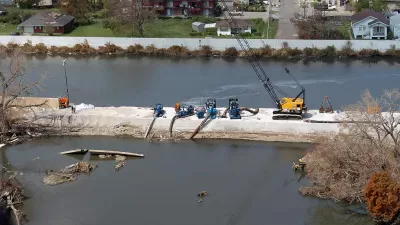The Times-Picayune reports that the Army Corps of Engineers, under pressure from penny-pinched local governments, has commenced a new pilot study that potentially relaxes the new, stricter standards for levees it set in place post-Katrina.
The Army Corps of Engineers has embarked on a new study in southern Louisiana that could eventually lead to more levee design and construction alternatives for municipalities in the region. The action raises questions about the most cost-effective types of levees and protection for coastal communities threatened by flooding from volatile weather and nearby bodies of water.
Local governments in the area saw costs rise dramatically when, in response to Hurricane Katrina, the corps developed new regulations mandating that levees protect threatened communities from 100-year storms. These are storms that have a one percent chance of occurring in a given year. If it is successful, the new corps study, formally titled the "Risk Based Criteria Optimization Study," may give communities the option to choose lesser, less expensive levels of protection. A wider array of less-protective levee options would potentially save the governments significant amounts of money and lessen a hefty financial burden that stems from the current requirement that state and local government pay 35 percent of the cost of levee construction.
Many academics and experts are concerned that relaxed flood protection standards and the acceptance of a higher flood risk would be a step in the wrong direction for threatened communities. The proposal has its fair share of critics, including those who believe that it places too much emphasis on the overtopping of levees by storm surge as the principal component of levee failure:
"Ray Seed, a civil engineering professor at the University of California at Berkeley, said the pilot study plan is flawed because it may not adequately consider some of the causes of levee failures in New Orleans, such as floodwaters seeping underneath earthen levees, causing them to collapse or move."
FULL STORY: Sturdier levee standards at risk

Study: Maui’s Plan to Convert Vacation Rentals to Long-Term Housing Could Cause Nearly $1 Billion Economic Loss
The plan would reduce visitor accommodation by 25,% resulting in 1,900 jobs lost.

North Texas Transit Leaders Tout Benefits of TOD for Growing Region
At a summit focused on transit-oriented development, policymakers discussed how North Texas’ expanded light rail system can serve as a tool for economic growth.

Why Should We Subsidize Public Transportation?
Many public transit agencies face financial stress due to rising costs, declining fare revenue, and declining subsidies. Transit advocates must provide a strong business case for increasing public transit funding.

How to Make US Trains Faster
Changes to boarding platforms and a switch to electric trains could improve U.S. passenger rail service without the added cost of high-speed rail.

Columbia’s Revitalized ‘Loop’ Is a Hub for Local Entrepreneurs
A focus on small businesses is helping a commercial corridor in Columbia, Missouri thrive.

Invasive Insect Threatens Minnesota’s Ash Forests
The Emerald Ash Borer is a rapidly spreading invasive pest threatening Minnesota’s ash trees, and homeowners are encouraged to plant diverse replacement species, avoid moving ash firewood, and monitor for signs of infestation.
Urban Design for Planners 1: Software Tools
This six-course series explores essential urban design concepts using open source software and equips planners with the tools they need to participate fully in the urban design process.
Planning for Universal Design
Learn the tools for implementing Universal Design in planning regulations.
City of Santa Clarita
Ascent Environmental
Institute for Housing and Urban Development Studies (IHS)
City of Grandview
Harvard GSD Executive Education
Toledo-Lucas County Plan Commissions
Salt Lake City
NYU Wagner Graduate School of Public Service



























